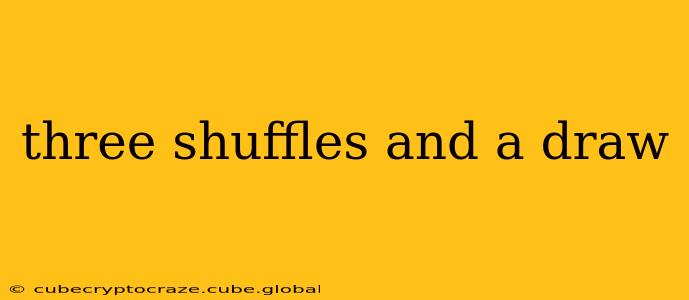Three Shuffles and a Draw: Understanding the Mathematics of Randomness in Card Games
The phrase "three shuffles and a draw" has become a common shorthand in discussions about card games and randomness. But how accurate is it? Does shuffling a deck of cards three times truly guarantee a perfectly random distribution? Let's delve into the fascinating mathematics behind shuffling and explore the implications for games of chance.
What does "three shuffles and a draw" actually mean?
The statement suggests that three shuffles are sufficient to randomize a deck of cards, making any subsequent draw completely unpredictable. This idea, while intuitively appealing, is a simplification of a much more complex process. It's a rule of thumb, often used in casual settings, but not a mathematically precise statement.
How many shuffles are actually needed for randomness?
The number of shuffles required for a truly random deck depends on several factors, including the type of shuffle used (riffle shuffle, overhand shuffle, etc.) and the definition of "random." Mathematicians have studied this extensively, and the general consensus is that seven riffle shuffles are generally considered sufficient to achieve a well-mixed deck. This is based on rigorous mathematical analysis that considers the statistical properties of different shuffling techniques.
Why are seven riffle shuffles recommended?
The seven-shuffle rule stems from the work of Persi Diaconis, a renowned mathematician specializing in probability. His research demonstrated that fewer shuffles leave patterns and correlations from the initial arrangement intact, influencing the probability of certain cards appearing in specific positions. Seven riffle shuffles, however, effectively breaks down these correlations, ensuring a high degree of randomness.
What are the different types of shuffles and how do they affect randomness?
Different shuffling techniques have varying degrees of efficiency in randomizing a deck.
- Riffle shuffle: This is the most commonly used method, where the deck is split roughly in half and the two halves are interleaved. It's efficient at randomizing cards.
- Overhand shuffle: Involves repeatedly lifting small portions of the deck from the top and dropping them onto the bottom. This method is less efficient at randomization than the riffle shuffle and requires more shuffles to achieve randomness.
- Cut: Simply dividing the deck into two portions and placing one on top of the other. This is not a shuffle in the true sense, and it doesn't improve randomness significantly.
How does the initial order of the cards affect randomness?
The initial order of the cards before shuffling significantly impacts the number of shuffles required to achieve a random distribution. A deck already partially randomized will need fewer shuffles compared to a perfectly ordered deck.
Is it possible to perfectly randomize a deck of cards?
True, perfect randomization is, in a theoretical sense, impossible. There's always a minuscule chance that the deck could be returned to its original order, or some other highly improbable arrangement. However, seven riffle shuffles bring the deck so close to perfectly random that for all practical purposes, the difference is negligible.
Does the number of cards in the deck affect the number of shuffles needed?
Yes, the number of cards does affect the required number of shuffles. A larger deck naturally requires more shuffles to achieve a similar degree of randomness compared to a smaller deck.
What are the practical implications for card games?
Understanding the mathematics behind shuffling is crucial for ensuring fairness and integrity in card games. While three shuffles might suffice for casual games, relying on a more rigorous approach (seven riffle shuffles) is recommended for games where fairness is paramount, such as poker tournaments or other competitive card games. Using a consistent shuffling technique also contributes to greater fairness and predictability of the randomization process.
In conclusion, while "three shuffles and a draw" is a catchy phrase, it's a significant oversimplification. For true randomness, especially in scenarios where fairness is critical, seven riffle shuffles are recommended as a more reliable and mathematically sound approach. Understanding the mathematical nuances of shuffling not only adds to our appreciation of card games but also emphasizes the subtle complexities of seemingly simple random processes.
